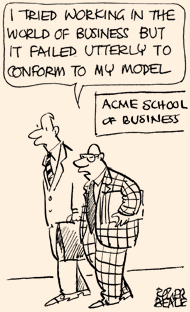Time to rejuvenate the tarnished reputation of research
Simply sign up to the Business education myFT Digest -- delivered directly to your inbox.
What use is the research coming out of business schools? What if the answer were “Not much!”?
Business school research, while excellent from an academic point of view, is often far removed from the challenges of today’s companies, not to mention costly. Many executives lament that it is unintelligible – useless even. So what can be done to save its tarnished reputation? To conduct research that is in touch with real corporate needs, the answer may lie in encouraging professors to venture out beyond the campus walls and become visiting professors …within companies.
Business school professors are frequently locked away in their ivory towers, cut off from the realities of corporate life. They spend their time grappling with the pressures of academia – the publish-or-perish track to tenure – and competing with colleagues at other universities, as well as those down the hall. This trend looks set to continue. The newest generation of PhDs have often never set foot inside a company, with their experience limited to labs and lecture halls. In the past these PhDs would mainly have conducted field experiments.

A huge divide is beginning to develop between what philosophers such as Gaston Bachelard, Maurice Merleau-Ponty and Karl Popper would have called the “I think” – the cogito world where research-professors evolve and the “I am” world of those in the field working within businesses.
Research must be thorough, of course, but its findings have to be relevant. As Charles de Gaulle once said; “Researchers that are researching are easy to find. We are searching for researchers that are finding!”. And what they find must have an impact on business, if not it is useless. Theories and models are not sufficient. No theory or model ever healed a neurosis or calmed a stressed-out executive. If research – even applied research – does not directly address the actual challenges faced by businesses, it is simply ‘inapplicable’, in the words of French sociologist Bruno Latour.
To perform research that is both in-depth and useful, business school professors must combine their intellectual understanding of what a company is with a practical knowledge of how a company works and must also develop an emotional intelligence about what businesses really are.
Professors need to stop being armchair generals and get out on to the battlefield. This will mean switching from the role of a savant to that of a student who has everything to learn.
To help professors make this switch I would advise them to carry out company visits. However, these should not be any old company visits. They should not be “roadshows” as held by some business schools to attract funding and lucrative research contracts. Nor should they be designed to encourage admin-intensive partnerships. Company visits should aim to give professors insight into the nuts-and-bolts of today’s organisations and how the people in them work and live.
I think that professors need first-hand experience of what life is like inside a modern company: the stress, conflict, burnout and order-book worries, as well as the achievements, celebrations, expansions and restructurings. If, on top of that, these professors also secure research contracts or executive education clients, then that should be the icing on the cake not the primary motivation.
Everyone needs a dose of reality. If, as business school professors, our everyday work is to become more relevant, we must accept that we have to get out of our intellectual comfort zone. We should take the time to meet others face to face, to share and to listen, so that we can better understand the real challenges we face.
Business school professors have only two alternatives – to bury their heads in the sand, refusing to see that the world has changed and run the risk of becoming marginalised, or to take on these new challenges and engage with the organisations of the 21st century.
The author is the dean of Grenoble Ecole de Management
Comments